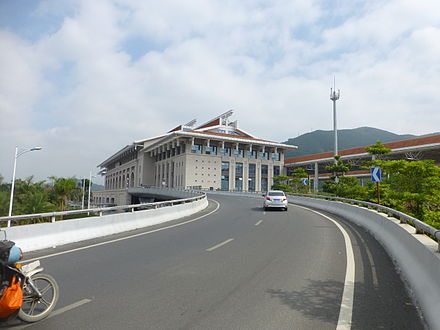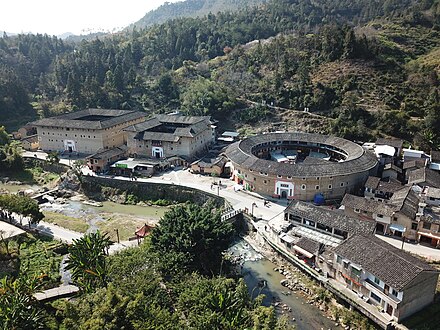Zhangzhou - prefecture-level city in Fujian, China
 Zhangzhou (漳州; Chiang-chiu in Minnan, Zhāngzhōu in Mandarin) is a city of 4.8 million people (2010) in the west of Fujian Province in China.
Zhangzhou (漳州; Chiang-chiu in Minnan, Zhāngzhōu in Mandarin) is a city of 4.8 million people (2010) in the west of Fujian Province in China.
Understand
Prefecture consists of: Xiangcheng District (芗城区), Longwen District (龙文区), Longhai City (龙海市), Changtai County (长泰县), Dongshan County (东山县), Hua'an County (华安县), Nanjing County (南靖县), Pinghe County (平和县), Yunxiao County (云霄县), Zhangpu County (漳浦县), Zhao'an County (诏安县)
Talk
Minnan is the main language spoken in Zhangzhou. The local dialect differs somewhat from that of neighbouring Xiamen, but they are still similar enough to be mutually intelligible. There are also dialectal differences between the Minnan spoken in different parts of the prefecture-level city, with the dialect in Zhao'an in particular having a strong Teochew influence, though in general, this should also not hinder communication too much. Most locals are also able to speak Mandarin, so Mandarin speakers would not have any problems getting around.
Get in
By bus
There are frequent buses from Xiamen (about 1 hour), as well as some direct service from most cities and counties in southern Fujian.
By train

The spacious new Zhangzhou Railway Station 📍 (which was known as Zhangzhou South during the planning stage) sits on the new high-speed railway (the Xiamen-Shenzhen line) about 10 km south of downtown Zhangzhou. Many of the high-speed trains travelling along the coast from Xiamen, Fuzhou and points north to Shenzhen stop here. There is also high-speed service inland to Longyan; many of the conventional trains from Xiamen to destinations in the interior of China use that line too.
The older Zhangzhou East Railway Station 📍 is remarkably inconveniently located (miles away from the city, with few signs posted along the road, and fairly limited bus service; even some of the locals have only a vague idea as to where it is). Many trains have been routed to the rail line south of the city and the Zhangzhou Railway Station, but a few (slower) trains run through Zhangzhou East.
Finally, there is the Zhangzhou North Station, just north of downtown Zhangzhou. Don't go there: even though older maps still call it "Zhangzhou Station" (this is how it was called until 2011), it has no passenger service anymore.
By plane
The closest passenger airport is in Xiamen.
Get around
The city has extensive local bus service, with several routes extending to outlying suburbs (some of which are really cities in their own right, such as Longhai).
By train
- Nanjing Railway Station (南靖火车站, 南靖站, Nanjing Station), Yanta Village, Shancheng Town (山城镇雁塔村), 24.5817°, 117.444°. High-speed trains from Xiamen take between 30 and 60 minutes. From Zhangzhou, the journey time is just 15 minutes. 2019-01-31
By bus
- Nanjing Bus Station (南靖车站, 南靖汽车站), 129-6 Renmin Road, Shancheng Town (山城镇人民路129-6, 24.5130071059°, 117.3689998763°, +86 596 7835824. There are regular daily buses from Xiamen. Buses depart from the Fang Lake Bus Station (枋湖汽车站) in Xiamen's Huli District. The journey time is about 2 hours. 2019-01-31
See
Zhangzhou urban area
- Zhangzhou Museum (漳州市博物馆), Intersection of Yingbin Avenue and Longwen South Road, Longwen District (龙文区迎宾大道与龙文南路加叉口) (Bus routes 1, 5, 10, 23, 27, 902, b3, b8, b10 and b13), 24.5108258558°, 117.7057196527°, +86 596 2108779, zzsbwg@126.com. 09ː00-12ː00, 14ː30-17ː00 (15ː00-17ː30 during the summer), closed on Mondays. Zhangzhou's main museum. Free 2019-02-02
- Nanshan Temple (南山寺), 11 Shuang'an Road, Xiangcheng District (芗城区双庵路11号) (Take bus no. 3 or 12 and get off at the pharmaceutical factory (制药厂) bus stop. From there, walk about 600 metres north down Nanshan Road), 24.5001°, 117.6417°, +86 596 2023939. 08ː30-17ː00. Built in the 8th century AD, the Nanshan Temple is one of the oldest and most important Buddhist temples in southeastern China. ¥10 2019-02-02

- Yundongyan Scenic Area (云洞岩风景区), Caiban Village, Lantian Town, Longwen District (龙文区蓝田镇蔡坂村) (Bus nos. 1, 6, 23, 25, 902, b6, sightseeing route 1 (观光1号线) and sightseeing route 2 (观光2号线)), 24.5141941377°, 117.7600090078°, +86 596 2102223, +86 596 2106258. 06ː30-18ː00. The only scenic area in Zhangzhou's main urban area to be designated as a 4A-rated tourist attraction by China's Ministry of Culture and Tourism. The main feature is a rocky hill named Yundongyan (literally ‘Cloud Cave Rock'), which stands about 280 metres above sea level. Free 2019-02-03
Rural Zhangzhou
Nanjing County
 Most people travel to Nanjing County to see the Fujian Tulou clusters.
Most people travel to Nanjing County to see the Fujian Tulou clusters.
Zhangpu County
The Liu'ao Peninsula, in the southern part of Zhangpu County, has the ruins of an ancient fortress, good beaches, and interesting rock formations.
Xihu She Ethnic Township, also in Zhangpu County, has two 17th-century fortresses: Zhaojiabao and Yi'anbao.
Do
Buy
Eat
Zhangzhou is most famous for its lor mee (卤面, lǔmiàn) braised noodles, the original version of a dish that's become even more well-known as an element of Singapore, Malaysia, and Indonesia cuisine. Other famous local specialities include muah chee (麻糍) and the local version of oyster omelette (蚵仔煎), which is different from the version in neighbouring Xiamen and the Taiwanese version, being crispier and served with pickled radish on the side.
Drink
Sleep
Accommodation within the century-old Fujian Tulou is possible, offering a unique cultural experience. Many of the guest houses and inns are family-run and allow for a glimpse into the local rural life.
Go next
Take a bus to Nanjing County or Yongding County, and see Fujian Tulou, large fortified earth buildings which are on the UNESCO World Heritage List. Or go the opposite way, to Xiamen which is the hub of the region and has the scenic island Gulangyu.
Zhangzhou
zhangzhou.gov.cnZhangzhou Shi
2nd-order administrative division
Fujian
Primary administrative division
